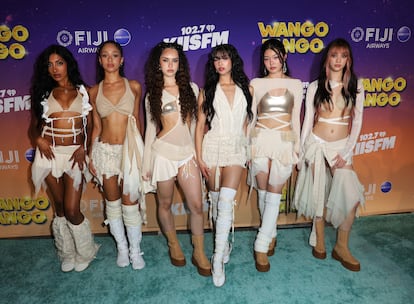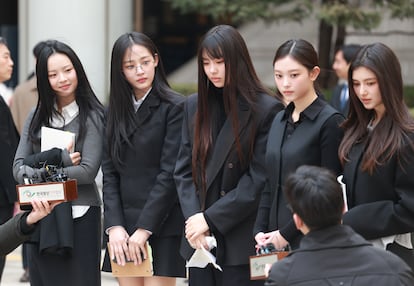“Imagine being in your 12th year of career and opening a concert for another group just because the group is western. This is the height of seeking Western validation”; “Nayeon and the rest of Twice are desperate to have western validation.” They are some of the comments on social networks that happened to the collaboration between the K-Pop Twice Korean band and the British Coldplay, who came from the hand of the television of the first to the latter on the six dates of the Chris Martin group in South Korea. They are not the only ones who have been criticized by their country’s fans with this term. “All art and vision of Jennie are nothing more than a desperate strategy to fit in the United States,” is a phrase that summarizes a current of opinion about Blackpink singer, who has just published her solo debut album, Ruby. “Can we agree that Lisa will never obtain western validation that seeks so desperately and will only lead Thailand’s charts?” Alter Ego. Both acted last April in the latest edition of Coachella, the most media festival in the world.
The beginning of the solo races of the members of Blackpink (who meet to play in Barcelona on August 9 of this year) has revived the debate not only around their Koreanity (Koress), but also about the questioning of the national character of the genre, especially for its apparent orientation towards a western validation strategy. One of the cultural explanations to this phenomenon is contributed by Julia Rodríguez Castillo (Granada, 32 years old), a doctor in communication from the University of Malaga and a researcher on the Korean wave (Hallyu): “The record records not only create stars, but also build the country brand. For years, the K-Pop is a centerpiece in the Korean brand, that is, in how South Korea is presented to the world.” Mathieu Berbiguier (Aviñón, France, 31 years), a doctorate in Korean studies from the University of Los Angeles, adds to the debate: “Many fans are not at all happy to see so many collaborations of Korean artists with Western artists in the project alone of Lisa or Jennie. She is linked to the language (singing in Korean) and having Korean/Asian features.
This summer, the La Mar de Musicas Festival of Cartagena has drawn connections with the South Korean country to focus its programming on the proposals of the Peninsula. Yunseul (Seoul, 23 years old), a member of the Bewave band (which will act on July 23 in the town), also points to the language as a differentiating element of the genre. “I think one of the most special things of K-Pop is the Korean language itself. It has a very rich sound, with rhythms and pronunciations that make it very versatile,” he replies by email.
The concept of western validation, however, is cheater per se: It presupposes that legitimate validation must come from Western cultural centers, thus perpetuating hierarchies of symbolic value. Berbiguier: “It is a bit exaggerated to call it that, it is also beneficial for Western artists to associate with K-Pop artists. For example, Halsey, when he participated in the song Boy With Luv With BTS, he received many praise. ”In reality, what is interpreted as a search for western approval can also be understood as a reterritorialization tactic of global success, where artists actively negotiate their place in a polycentric cultural market.“ It is a reflection of the evolution of the dynamics of power between what is considered mainstream And what is not, and how K-Pop is often considered a threat to pop music mainstream Western, ”continues Berbiguier.
As a consequence, the K-Pop, becoming a global phenomenon, has begun to be evaluated under the standards of authenticity that predominate in Anglo-Saxon cultural markets and, by extension, in Hispanics. These standards value authorship, coherent biographical narrative and supposed emotional transparency as indicators of artistic legitimacy, in contrast to the industrial logic of the K-POP, which has traditionally prioritized technical perfection, collective production and fictional construction of the idol (term used in the genre, which, simplifying, defines the idol/artist led by the K-Pop industry).
“The controversy explodes again on the playback In the K-Pop industry, ”he titled a report The Korea Herald, One of the most important English newspapers in the country, about the presence of Lisa in the 2024 MTV Video Music Awards, whose performance in Coachella is again in the spotlight for the same reason. “In Europe, consumption is more digital and fragmented: we arrive at the K-Pop through YouTube, Tiktok or Instagram, and we look for a more spontaneous or real connection with the artists. We look more at whether they show their personality or if they seem free in their decisions,” says Rodríguez Castillo, adding a new layer to that authenticity that the West imposes.
This hybridization of values is materialized, for example, in the recent appearance of the Katseye group, sextet that operates under an agreement between Hybe (South Korean record) and Geffen Records (American). The band is mostly composed of non -Korean members, selected through a casting Global, although it occurs under the same aesthetic, performative, legal and production umbrella that has characterized the genre. The group debuted accompanied by the series Popstar Academy (In Netflix), who documented the audition process, and that was what gave them authenticity within the South Korean followers community despite being a foreign band, “because it showed that the girls worked hard to debut and meet the expectations of a K-Pop group,” says Berbiguier. Training, therefore, was the same as that of any other aspiring idol. Yunseul contributes: “We constantly practice to show the best of ourselves.” Lena (Wakayama, Japan, 23 years old), a bandmate, joined the team “through another audition program.” “I just planned to stay in Korea for a week, and in the end were three months of the selection process. Every day I practice the songs of our group, we constantly recorded and, if something does not fit, we focus on perfecting the details,” add the Katseye component.
The globalization of the genre has not only visible its aesthetic and sound codes, but also the power structures that articulate it from within: total assignment of image and production rights, disciplinary regimes that regulate from the body to the personal relationships of the idols, and a corporate logic in which the artistic figure is subordinated to business objectives. As K-Pop becomes an international cultural product, these practices have begun to be perceived as incompatible with labor standards that govern other creative industries.
“I think that the strict and highly structured nature of the K-Pop industry is often evil in Europe due to all this discourse around the dark side of the genre. I would define this as an orientalist narrative that exaggerates and focuses only on the negative aspects of the industry, as if other industries of dominant popular culture did not have similar problems. This point shows a desire to exorcise the K-Pop in response to justify its response to justify its response to justify its response to justify its response to popularity, ”says Berbiguier, putting the example of Popstar Academy.

One of the direct consequences of this tension has been the emergence of increasingly visible internal conflicts, such as the recent case between the members of Newjaans and the Hybe company. Ador is the Hybe subsidiary led by Min Hee-Jin, whose best known band is Newjaans. The conflict emerged in April 2024, when Hybe undertook an internal audit to adorn under the suspicion that his CEO tried to acquire total control of the company. The dispute reached a new critical point in November, when the quintet announced the cessation of its activity with Ador. However, in March 2025, a court ruled in favor of the seal, preventing the band (renowned as NJZ) to act independently, which further intensified media attention to the structure of the system idol.
To the extent that the phenomenon transcends the borders of South Korea, complex questions emerge about the authenticity of the genre, the underlying exploitation of artists and hierarchies that their global success hides. The perception of the search for western validation, often interpreted as an effort to adapt to the canons of a hegemonic cultural market, can, however, be rethink as a negotiation strategy within a polysemic global context, where artists try to redefine their positions in an increasingly diversified market.

